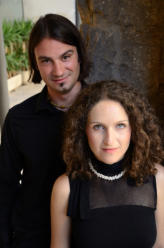Cantar alla Viola, the art of accompanying the voice with the viola da gamba, is
the largely-forgotten technique of using a bowed instrument to play polyphony and
harmony as an accompaniment to the voice. The rediscovery of these methods
inspired Nadine Balbeisi, soprano, and Fernando Marín, viola da gamba, to create
their duo of the same name. Detailed descriptions of the practice of this delicate
manner of accompanying the voice are found in sources such as "Regola Rubertina"
by Sylvestro Ganassi (1542) and in "Il libro del cortegliano" by Baldassare
Castiglione, Venezia (1528). As suggested by Ganassi’s instructions, Fernando Marín
adapts madrigals and songs from the Renaissance and early Baroque for the voice
and viol.
The duo researches and makes use of the different kinds of violas da gamba used to
accompany the voice, such as the Spanish Vihuela de arco, the bowed version of the
Vihuela de mano (plucked), and the English Lyra-viol. Both have been reproduced
following the shapes and dimensions as well as building techniques of original
instruments. Historical bows and strings are just as carefully researched and
selected. The harmonies of the instruments are sustained by using a special bowing
technique which creates a sound that mixes well with the human voice.
Cantar alla Viola has performed in festivals and concert series in Germany, Spain,
and the Czech Republic. The duo has been a finalist on two occasions in the competition for early music in Antwerp, the
International Young Artist’s Presentation. Through their extensive research of the repertoire for this combination they have
encountered lesser-known composers whose works they have introduced in concert and on their critically acclaimed CDs
“The Complete Polyphonic Works of Juan Blas de Castro (1561-1631),” “Robert Jones: The Second Booke of Songs and Ayres
(1601)” and “The Vihuela de arco in the reign of Aragon.”
The American/Jordanian Soprano, Nadine Balbeisi began her solo career, singing Oratorio, Chamber music, Opera and
Recitals, after moving to Germany. Active as an early music singer, her repertoire extends from the 15th through 18th
Centuries. She received a Bachelor’s degree in vocal performance from the University of Michigan studying with George
Shirley and obtained a second degree from the Hochschule für Musik Köln with Barbara Schlick. A prizewinner of the
Kammeroper Schloß Rheinsberg International Competition, Ms. Balbeisi has performed a wide range of roles including
Adele, Bastienne, Despina, Dido, Papagena, Serpina, etc. She was awarded the post of Artist in Residence in Spain,
researching and performing 16th Century Polyphony from the archives of the Cathedral of Huesca.
Originally from Alicante, Fernando Marín has obtained an international musical education having studied in Prague,
Cologne and Brussels. He received a Cello Degree from el Conservatorio de Oviedo, and Degrees in Viola da Gamba and
Chamber Music at the Hochschule für Musik Köln, studying with Alexander Fedortchenco and Wieland Kuijken (Brussels).
His concert engagements as a soloist and basso continuo player have taken him to Mexico, Holland, Belgium, the Czech
Republic and Poland. Marin’s specialization in rediscovered instruments from the sixteenth century, such as the Vihuela de
arco and the Lyra-viol, has been a highlight of his endeavours. He has researched the origins, methods of playing and
repertoire of these instruments, developing a technique of accompanying the voice which can be heard in performances and
recordings of his duo Cantar alla Viola. Besides several CDs with this duo he has recorded a solo viola da gamba CD
“eVIOLution.” Marín has also written articles on musical rhetoric and improvisation which have been published by
musicological journals “Nassarre“ and “Quodlibet.“ He is a founding member of the Association for the Historical
Interpretation of Music and Art (“La Asociación para la Interpretación Histórica de la Música y del Arte“

Cantar alla Viola, the art of
accompanying the voice with the
viola da gamba, is the largely-
forgotten technique of using a
bowed instrument to play
polyphony and harmony as an
accompaniment to the voice. The
rediscovery of these methods
inspired Nadine Balbeisi,
soprano, and Fernando Marín,
viola da gamba, to create their
duo of the same name. Detailed descriptions of the
practice of this delicate manner of accompanying the
voice are found in sources such as "Regola Rubertina"
by Sylvestro Ganassi (1542) and in "Il libro del
cortegliano" by Baldassare Castiglione, Venezia (1528).
As suggested by Ganassi’s instructions, Fernando
Marín adapts madrigals and songs from the
Renaissance and early Baroque for the voice and viol.
The duo researches and makes use of the different
kinds of violas da gamba used to accompany the voice,
such as the Spanish Vihuela de arco, the bowed version
of the Vihuela de mano (plucked), and the English Lyra-
viol. Both have been reproduced following the shapes
and dimensions as well as building techniques of
original instruments. Historical bows and strings are
just as carefully researched and selected. The
harmonies of the instruments are sustained by using a
special bowing technique which creates a sound that
mixes well with the human voice.


the sound of excellence


the sound of excellence














